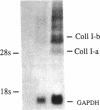Abstract
Cardiac hypertrophy is largely due to cardiac fibroblast growth and increased synthesis of extracellular matrix. This study has investigated the contribution of the vasoactive hormone, angiotensin II, toward this hypertrophic process. We have demonstrated that cultures of adult rat cardiac fibroblasts express AT1 but not AT2 receptors for angiotensin II. The ability of angiotensin II to stimulate phosphoinositide catabolism and to elevate intracellular calcium concentrations in these cells was blocked by losartan, a specific AT1 receptor antagonist, but not by the AT2 receptor antagonist CGP 42112. Exposure of adult cardiac fibroblasts to angiotensin II resulted in the induction of several growth-related metabolic events including c-fos protooncogene expression and increased synthesis of DNA, RNA, and protein. Angiotensin II was also found to induce collagen type I, alpha 1 chain transcript expression in cardiac fibroblasts as well as the synthesis and secretion of collagen by these cells. The data demonstrate that angiotensin II, via AT1 receptors, can stimulate cardiac fibroblast growth and increase collagen synthesis in cardiac tissue. Thus, angiotensin II may contribute toward the development of cardiac hypertrophy in conditions of hypertension that are associated with elevated concentrations of angiotensin II.
Full text
PDF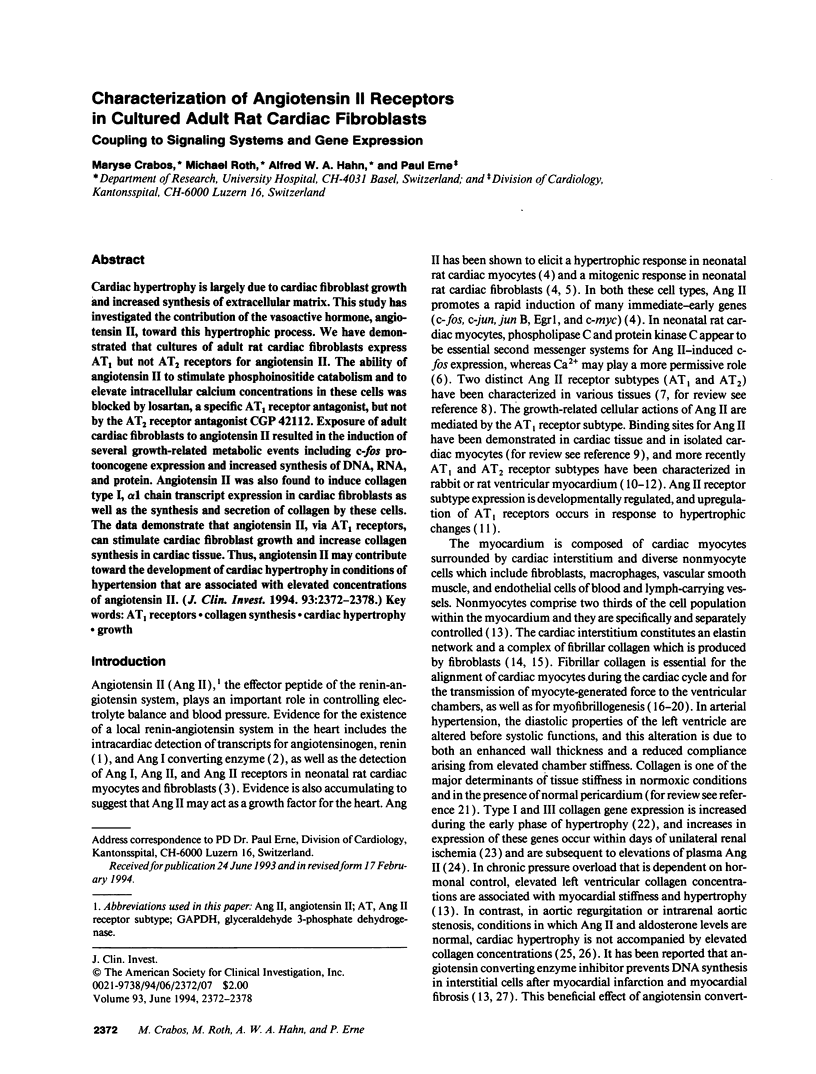
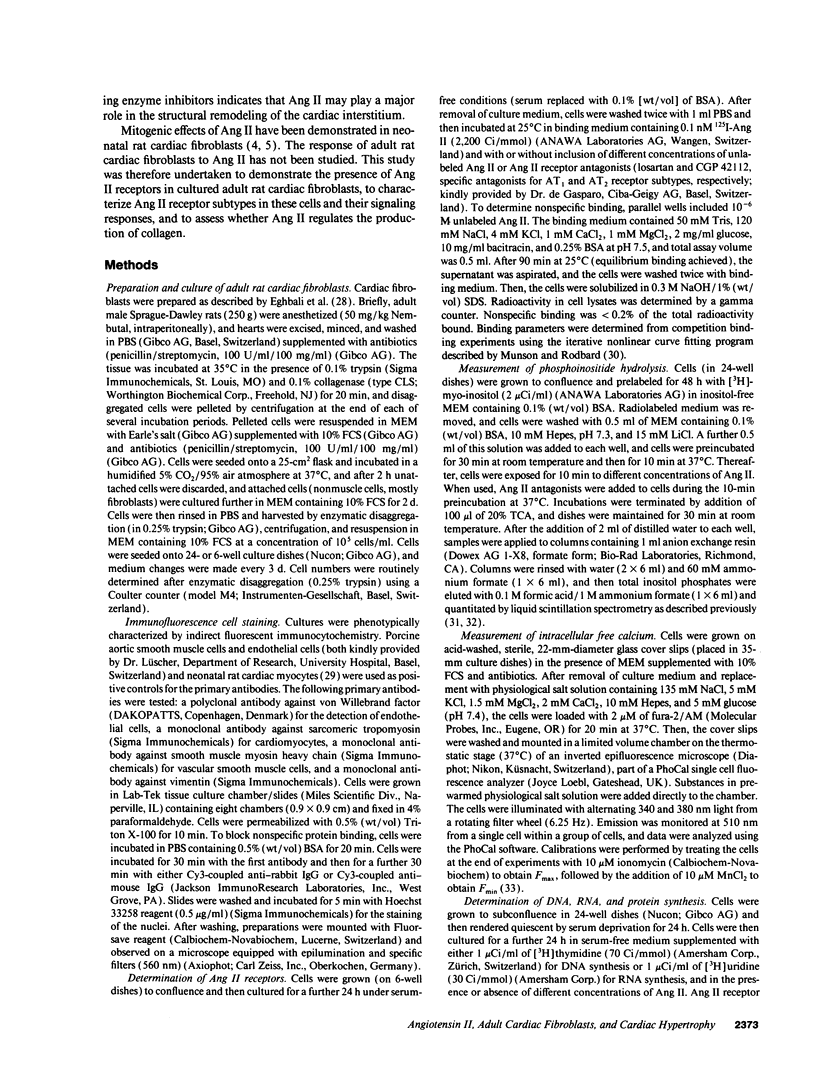
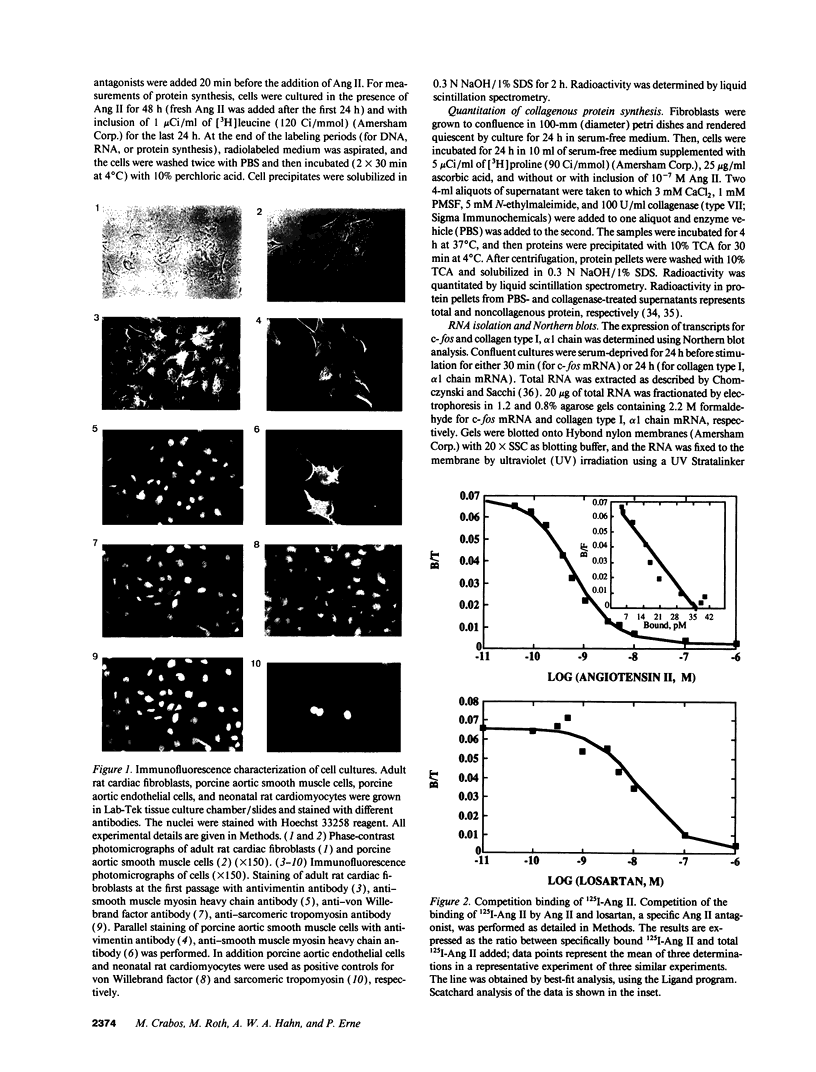
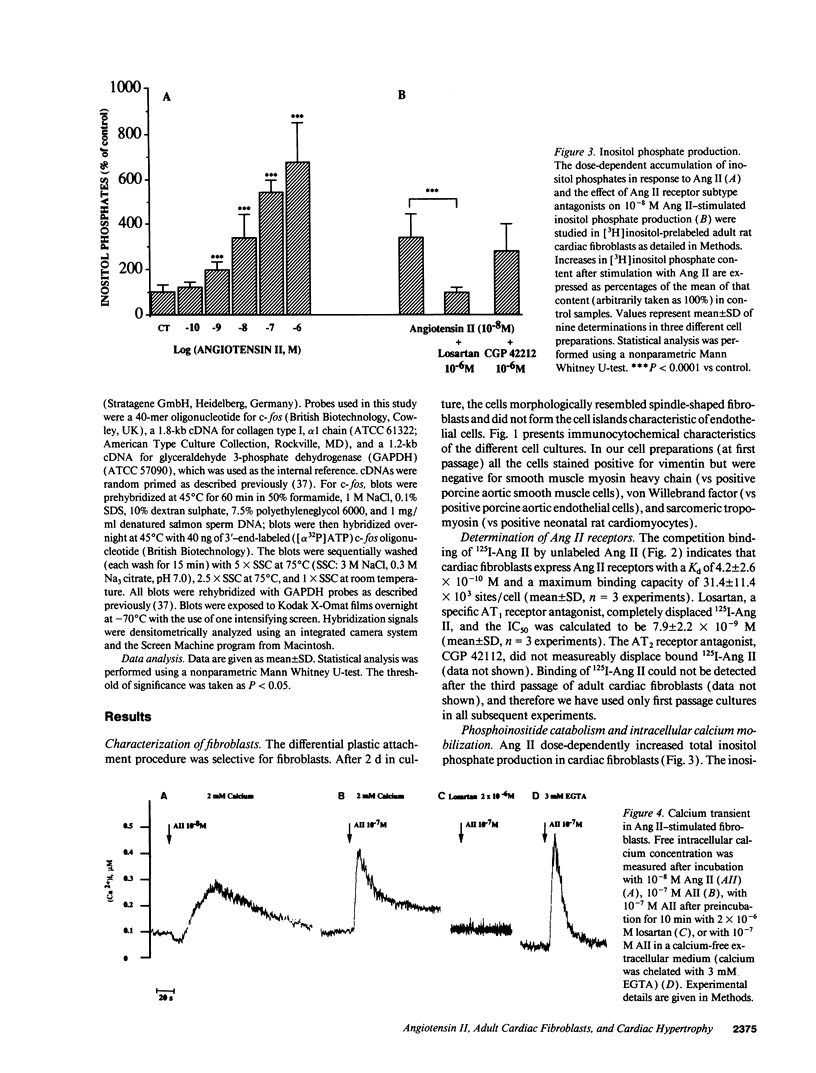
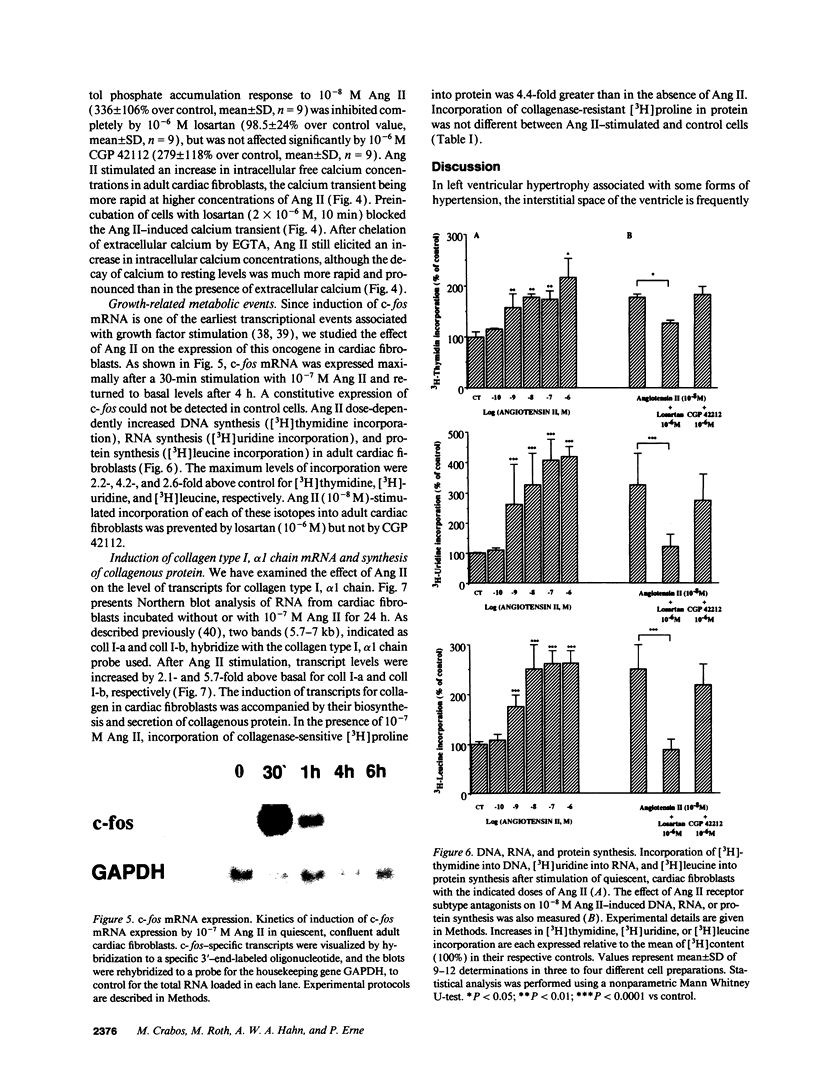
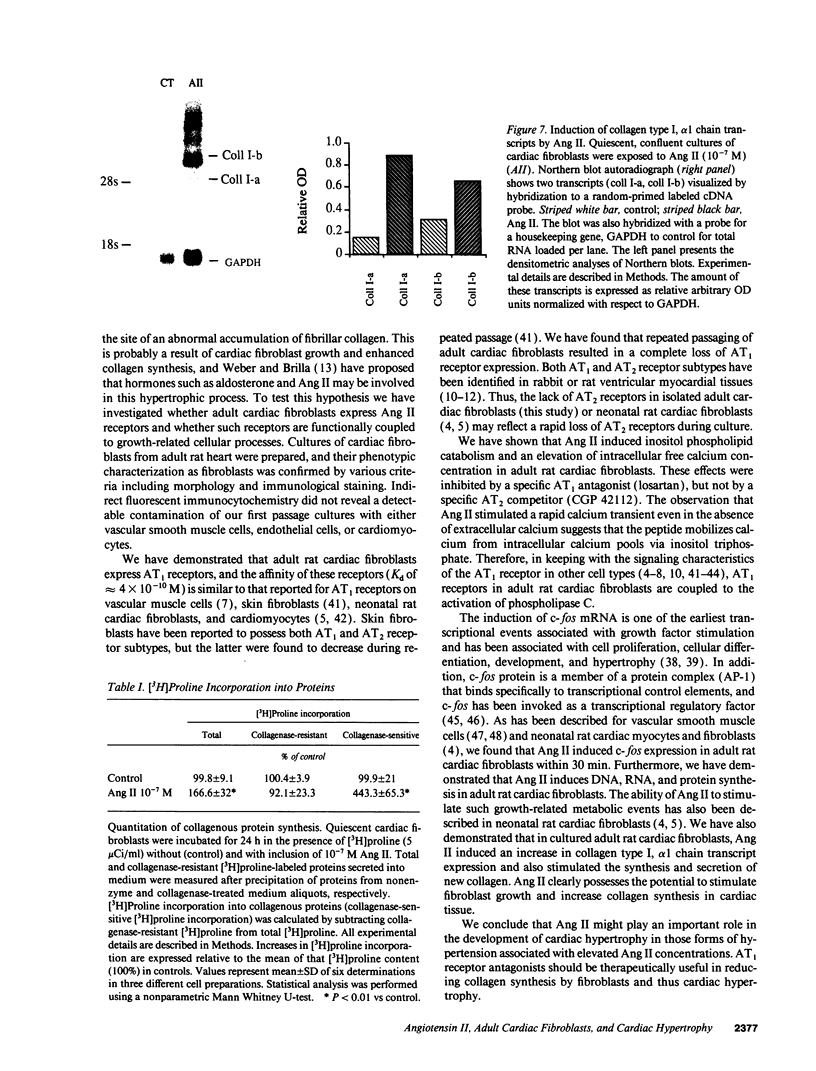
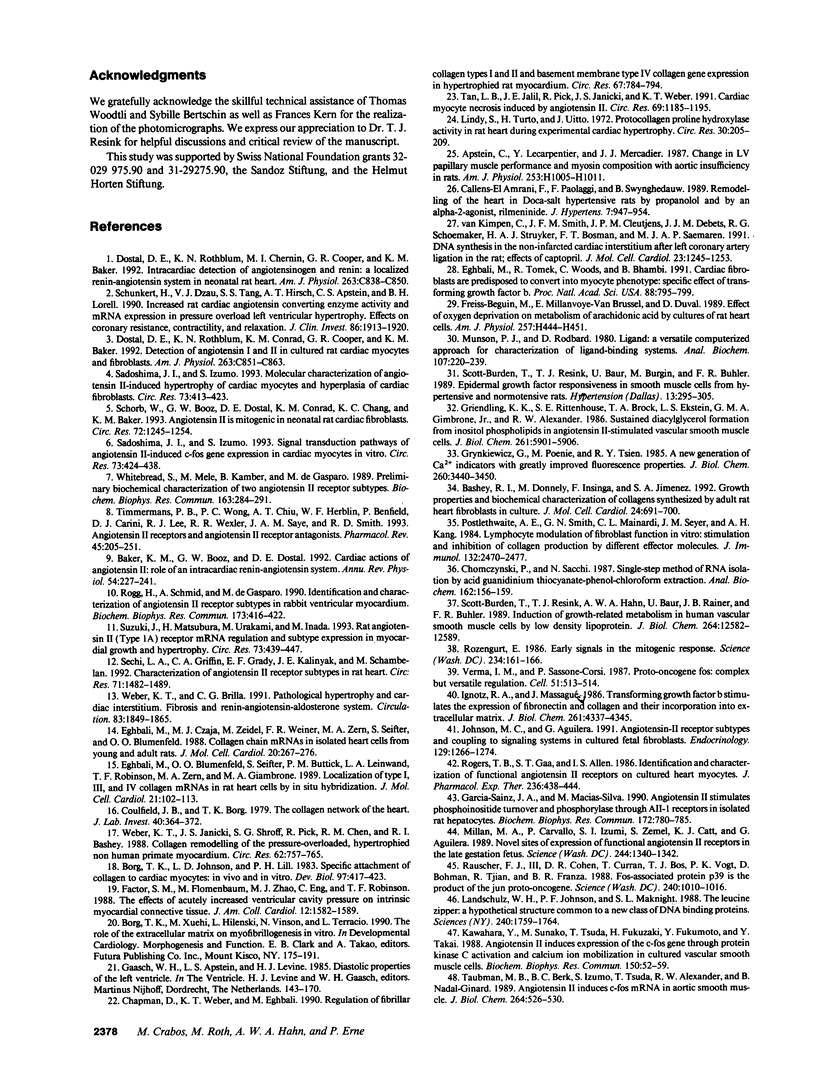
Images in this article
Selected References
These references are in PubMed. This may not be the complete list of references from this article.
- Baker K. M., Booz G. W., Dostal D. E. Cardiac actions of angiotensin II: Role of an intracardiac renin-angiotensin system. Annu Rev Physiol. 1992;54:227–241. doi: 10.1146/annurev.ph.54.030192.001303. [DOI] [PubMed] [Google Scholar]
- Bashey R. I., Donnelly M., Insinga F., Jimenez S. A. Growth properties and biochemical characterization of collagens synthesized by adult rat heart fibroblasts in culture. J Mol Cell Cardiol. 1992 Jul;24(7):691–700. doi: 10.1016/0022-2828(92)93383-u. [DOI] [PubMed] [Google Scholar]
- Borg T. K., Johnson L. D., Lill P. H. Specific attachment of collagen to cardiac myocytes: in vivo and in vitro. Dev Biol. 1983 Jun;97(2):417–423. doi: 10.1016/0012-1606(83)90098-2. [DOI] [PubMed] [Google Scholar]
- Callens-el Amrani F., Paolaggi F., Swynghedauw B. Remodelling of the heart in DOCA-salt hypertensive rats by propranolol and by an alpha-2 agonist, rilmenidine. J Hypertens. 1989 Dec;7(12):947–954. doi: 10.1097/00004872-198912000-00004. [DOI] [PubMed] [Google Scholar]
- Caulfield J. B., Borg T. K. The collagen network of the heart. Lab Invest. 1979 Mar;40(3):364–372. [PubMed] [Google Scholar]
- Chapman D., Weber K. T., Eghbali M. Regulation of fibrillar collagen types I and III and basement membrane type IV collagen gene expression in pressure overloaded rat myocardium. Circ Res. 1990 Oct;67(4):787–794. doi: 10.1161/01.res.67.4.787. [DOI] [PubMed] [Google Scholar]
- Chomczynski P., Sacchi N. Single-step method of RNA isolation by acid guanidinium thiocyanate-phenol-chloroform extraction. Anal Biochem. 1987 Apr;162(1):156–159. doi: 10.1006/abio.1987.9999. [DOI] [PubMed] [Google Scholar]
- Dostal D. E., Rothblum K. N., Chernin M. I., Cooper G. R., Baker K. M. Intracardiac detection of angiotensinogen and renin: a localized renin-angiotensin system in neonatal rat heart. Am J Physiol. 1992 Oct;263(4 Pt 1):C838–C850. doi: 10.1152/ajpcell.1992.263.4.C838. [DOI] [PubMed] [Google Scholar]
- Dostal D. E., Rothblum K. N., Conrad K. M., Cooper G. R., Baker K. M. Detection of angiotensin I and II in cultured rat cardiac myocytes and fibroblasts. Am J Physiol. 1992 Oct;263(4 Pt 1):C851–C863. doi: 10.1152/ajpcell.1992.263.4.C851. [DOI] [PubMed] [Google Scholar]
- Eghbali M., Blumenfeld O. O., Seifter S., Buttrick P. M., Leinwand L. A., Robinson T. F., Zern M. A., Giambrone M. A. Localization of types I, III and IV collagen mRNAs in rat heart cells by in situ hybridization. J Mol Cell Cardiol. 1989 Jan;21(1):103–113. doi: 10.1016/0022-2828(89)91498-3. [DOI] [PubMed] [Google Scholar]
- Eghbali M., Czaja M. J., Zeydel M., Weiner F. R., Zern M. A., Seifter S., Blumenfeld O. O. Collagen chain mRNAs in isolated heart cells from young and adult rats. J Mol Cell Cardiol. 1988 Mar;20(3):267–276. doi: 10.1016/s0022-2828(88)80059-2. [DOI] [PubMed] [Google Scholar]
- Eghbali M., Tomek R., Woods C., Bhambi B. Cardiac fibroblasts are predisposed to convert into myocyte phenotype: specific effect of transforming growth factor beta. Proc Natl Acad Sci U S A. 1991 Feb 1;88(3):795–799. doi: 10.1073/pnas.88.3.795. [DOI] [PMC free article] [PubMed] [Google Scholar]
- Factor S. M., Flomenbaum M., Zhao M. J., Eng C., Robinson T. F. The effects of acutely increased ventricular cavity pressure on intrinsic myocardial connective tissue. J Am Coll Cardiol. 1988 Dec;12(6):1582–1589. doi: 10.1016/s0735-1097(88)80029-9. [DOI] [PubMed] [Google Scholar]
- Freyss-Beguin M., Millanvoye-van Brussel E., Duval D. Effect of oxygen deprivation on metabolism of arachidonic acid by cultures of rat heart cells. Am J Physiol. 1989 Aug;257(2 Pt 2):H444–H451. doi: 10.1152/ajpheart.1989.257.2.H444. [DOI] [PubMed] [Google Scholar]
- García-Sáinz J. A., Macías-Silva M. Angiotensin II stimulates phosphoinositide turnover and phosphorylase through AII-1 receptors in isolated rat hepatocytes. Biochem Biophys Res Commun. 1990 Oct 30;172(2):780–785. doi: 10.1016/0006-291x(90)90742-6. [DOI] [PubMed] [Google Scholar]
- Griendling K. K., Rittenhouse S. E., Brock T. A., Ekstein L. S., Gimbrone M. A., Jr, Alexander R. W. Sustained diacylglycerol formation from inositol phospholipids in angiotensin II-stimulated vascular smooth muscle cells. J Biol Chem. 1986 May 5;261(13):5901–5906. [PubMed] [Google Scholar]
- Grynkiewicz G., Poenie M., Tsien R. Y. A new generation of Ca2+ indicators with greatly improved fluorescence properties. J Biol Chem. 1985 Mar 25;260(6):3440–3450. [PubMed] [Google Scholar]
- Johnson M. C., Aguilera G. Angiotensin-II receptor subtypes and coupling to signaling systems in cultured fetal fibroblasts. Endocrinology. 1991 Sep;129(3):1266–1274. doi: 10.1210/endo-129-3-1266. [DOI] [PubMed] [Google Scholar]
- Kawahara Y., Sunako M., Tsuda T., Fukuzaki H., Fukumoto Y., Takai Y. Angiotensin II induces expression of the c-fos gene through protein kinase C activation and calcium ion mobilization in cultured vascular smooth muscle cells. Biochem Biophys Res Commun. 1988 Jan 15;150(1):52–59. doi: 10.1016/0006-291x(88)90485-8. [DOI] [PubMed] [Google Scholar]
- Landschulz W. H., Johnson P. F., McKnight S. L. The leucine zipper: a hypothetical structure common to a new class of DNA binding proteins. Science. 1988 Jun 24;240(4860):1759–1764. doi: 10.1126/science.3289117. [DOI] [PubMed] [Google Scholar]
- Lindy S., Turto H., Uitto J. Protocollagen proline hydroxylase activity in rat heart during experimental cardiac hypertrophy. Circ Res. 1972 Feb;30(2):205–209. doi: 10.1161/01.res.30.2.205. [DOI] [PubMed] [Google Scholar]
- Millan M. A., Carvallo P., Izumi S., Zemel S., Catt K. J., Aguilera G. Novel sites of expression of functional angiotensin II receptors in the late gestation fetus. Science. 1989 Jun 16;244(4910):1340–1342. doi: 10.1126/science.2734613. [DOI] [PubMed] [Google Scholar]
- Munson P. J., Rodbard D. Ligand: a versatile computerized approach for characterization of ligand-binding systems. Anal Biochem. 1980 Sep 1;107(1):220–239. doi: 10.1016/0003-2697(80)90515-1. [DOI] [PubMed] [Google Scholar]
- Postlethwaite A. E., Smith G. N., Mainardi C. L., Seyer J. M., Kang A. H. Lymphocyte modulation of fibroblast function in vitro: stimulation and inhibition of collagen production by different effector molecules. J Immunol. 1984 May;132(5):2470–2477. [PubMed] [Google Scholar]
- Rauscher F. J., 3rd, Cohen D. R., Curran T., Bos T. J., Vogt P. K., Bohmann D., Tjian R., Franza B. R., Jr Fos-associated protein p39 is the product of the jun proto-oncogene. Science. 1988 May 20;240(4855):1010–1016. doi: 10.1126/science.3130660. [DOI] [PubMed] [Google Scholar]
- Rogers T. B., Gaa S. T., Allen I. S. Identification and characterization of functional angiotensin II receptors on cultured heart myocytes. J Pharmacol Exp Ther. 1986 Feb;236(2):438–444. [PubMed] [Google Scholar]
- Rogg H., Schmid A., de Gasparo M. Identification and characterization of angiotensin II receptor subtypes in rabbit ventricular myocardium. Biochem Biophys Res Commun. 1990 Nov 30;173(1):416–422. doi: 10.1016/s0006-291x(05)81074-5. [DOI] [PubMed] [Google Scholar]
- Rozengurt E. Early signals in the mitogenic response. Science. 1986 Oct 10;234(4773):161–166. doi: 10.1126/science.3018928. [DOI] [PubMed] [Google Scholar]
- Sadoshima J., Izumo S. Molecular characterization of angiotensin II--induced hypertrophy of cardiac myocytes and hyperplasia of cardiac fibroblasts. Critical role of the AT1 receptor subtype. Circ Res. 1993 Sep;73(3):413–423. doi: 10.1161/01.res.73.3.413. [DOI] [PubMed] [Google Scholar]
- Sadoshima J., Izumo S. Signal transduction pathways of angiotensin II--induced c-fos gene expression in cardiac myocytes in vitro. Roles of phospholipid-derived second messengers. Circ Res. 1993 Sep;73(3):424–438. doi: 10.1161/01.res.73.3.424. [DOI] [PubMed] [Google Scholar]
- Schorb W., Booz G. W., Dostal D. E., Conrad K. M., Chang K. C., Baker K. M. Angiotensin II is mitogenic in neonatal rat cardiac fibroblasts. Circ Res. 1993 Jun;72(6):1245–1254. doi: 10.1161/01.res.72.6.1245. [DOI] [PubMed] [Google Scholar]
- Schunkert H., Dzau V. J., Tang S. S., Hirsch A. T., Apstein C. S., Lorell B. H. Increased rat cardiac angiotensin converting enzyme activity and mRNA expression in pressure overload left ventricular hypertrophy. Effects on coronary resistance, contractility, and relaxation. J Clin Invest. 1990 Dec;86(6):1913–1920. doi: 10.1172/JCI114924. [DOI] [PMC free article] [PubMed] [Google Scholar]
- Scott-Burden T., Resink T. J., Baur U., Bürgin M., Bühler F. R. Epidermal growth factor responsiveness in smooth muscle cells from hypertensive and normotensive rats. Hypertension. 1989 Apr;13(4):295–304. doi: 10.1161/01.hyp.13.4.295. [DOI] [PubMed] [Google Scholar]
- Scott-Burden T., Resink T. J., Hahn A. W., Baur U., Box R. J., Bühler F. R. Induction of growth-related metabolism in human vascular smooth muscle cells by low density lipoprotein. J Biol Chem. 1989 Jul 25;264(21):12582–12589. [PubMed] [Google Scholar]
- Sechi L. A., Griffin C. A., Grady E. F., Kalinyak J. E., Schambelan M. Characterization of angiotensin II receptor subtypes in rat heart. Circ Res. 1992 Dec;71(6):1482–1489. doi: 10.1161/01.res.71.6.1482. [DOI] [PubMed] [Google Scholar]
- Suzuki J., Matsubara H., Urakami M., Inada M. Rat angiotensin II (type 1A) receptor mRNA regulation and subtype expression in myocardial growth and hypertrophy. Circ Res. 1993 Sep;73(3):439–447. doi: 10.1161/01.res.73.3.439. [DOI] [PubMed] [Google Scholar]
- Tan L. B., Jalil J. E., Pick R., Janicki J. S., Weber K. T. Cardiac myocyte necrosis induced by angiotensin II. Circ Res. 1991 Nov;69(5):1185–1195. doi: 10.1161/01.res.69.5.1185. [DOI] [PubMed] [Google Scholar]
- Taubman M. B., Berk B. C., Izumo S., Tsuda T., Alexander R. W., Nadal-Ginard B. Angiotensin II induces c-fos mRNA in aortic smooth muscle. Role of Ca2+ mobilization and protein kinase C activation. J Biol Chem. 1989 Jan 5;264(1):526–530. [PubMed] [Google Scholar]
- Timmermans P. B., Wong P. C., Chiu A. T., Herblin W. F., Benfield P., Carini D. J., Lee R. J., Wexler R. R., Saye J. A., Smith R. D. Angiotensin II receptors and angiotensin II receptor antagonists. Pharmacol Rev. 1993 Jun;45(2):205–251. [PubMed] [Google Scholar]
- Verma I. M., Sassone-Corsi P. Proto-oncogene fos: complex but versatile regulation. Cell. 1987 Nov 20;51(4):513–514. doi: 10.1016/0092-8674(87)90115-2. [DOI] [PubMed] [Google Scholar]
- Weber K. T., Brilla C. G. Pathological hypertrophy and cardiac interstitium. Fibrosis and renin-angiotensin-aldosterone system. Circulation. 1991 Jun;83(6):1849–1865. doi: 10.1161/01.cir.83.6.1849. [DOI] [PubMed] [Google Scholar]
- Weber K. T., Janicki J. S., Shroff S. G., Pick R., Chen R. M., Bashey R. I. Collagen remodeling of the pressure-overloaded, hypertrophied nonhuman primate myocardium. Circ Res. 1988 Apr;62(4):757–765. doi: 10.1161/01.res.62.4.757. [DOI] [PubMed] [Google Scholar]
- Whitebread S., Mele M., Kamber B., de Gasparo M. Preliminary biochemical characterization of two angiotensin II receptor subtypes. Biochem Biophys Res Commun. 1989 Aug 30;163(1):284–291. doi: 10.1016/0006-291x(89)92133-5. [DOI] [PubMed] [Google Scholar]
- van Krimpen C., Smits J. F., Cleutjens J. P., Debets J. J., Schoemaker R. G., Struyker Boudier H. A., Bosman F. T., Daemen M. J. DNA synthesis in the non-infarcted cardiac interstitium after left coronary artery ligation in the rat: effects of captopril. J Mol Cell Cardiol. 1991 Nov;23(11):1245–1253. doi: 10.1016/0022-2828(91)90082-w. [DOI] [PubMed] [Google Scholar]















